Trash talk analysis: Bloomington city councilmembers want to rethink cart fees
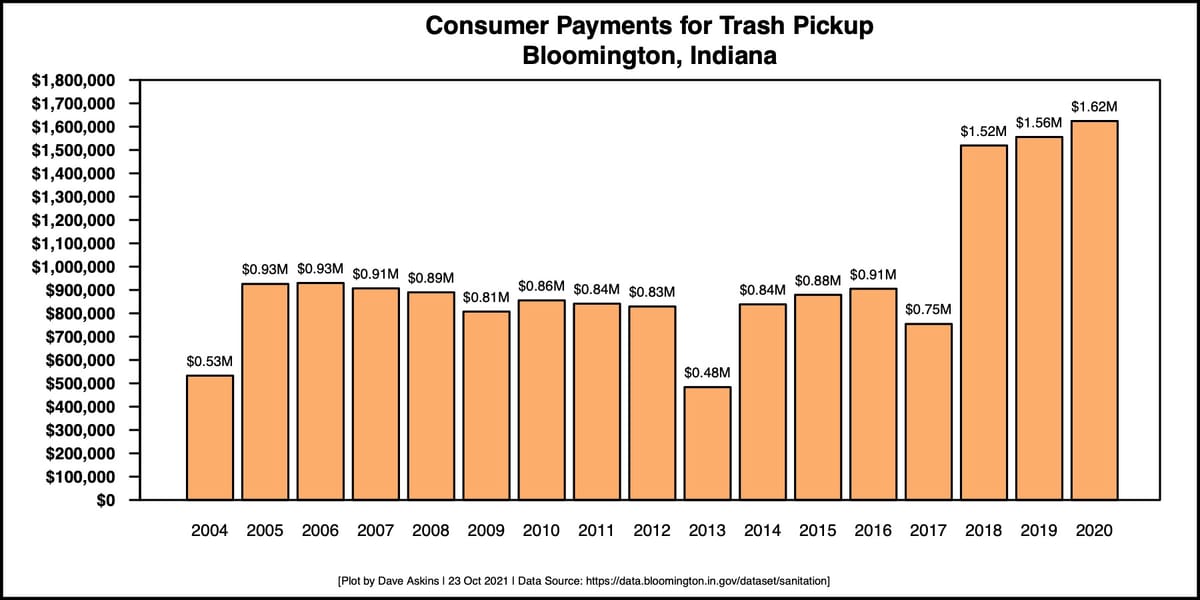
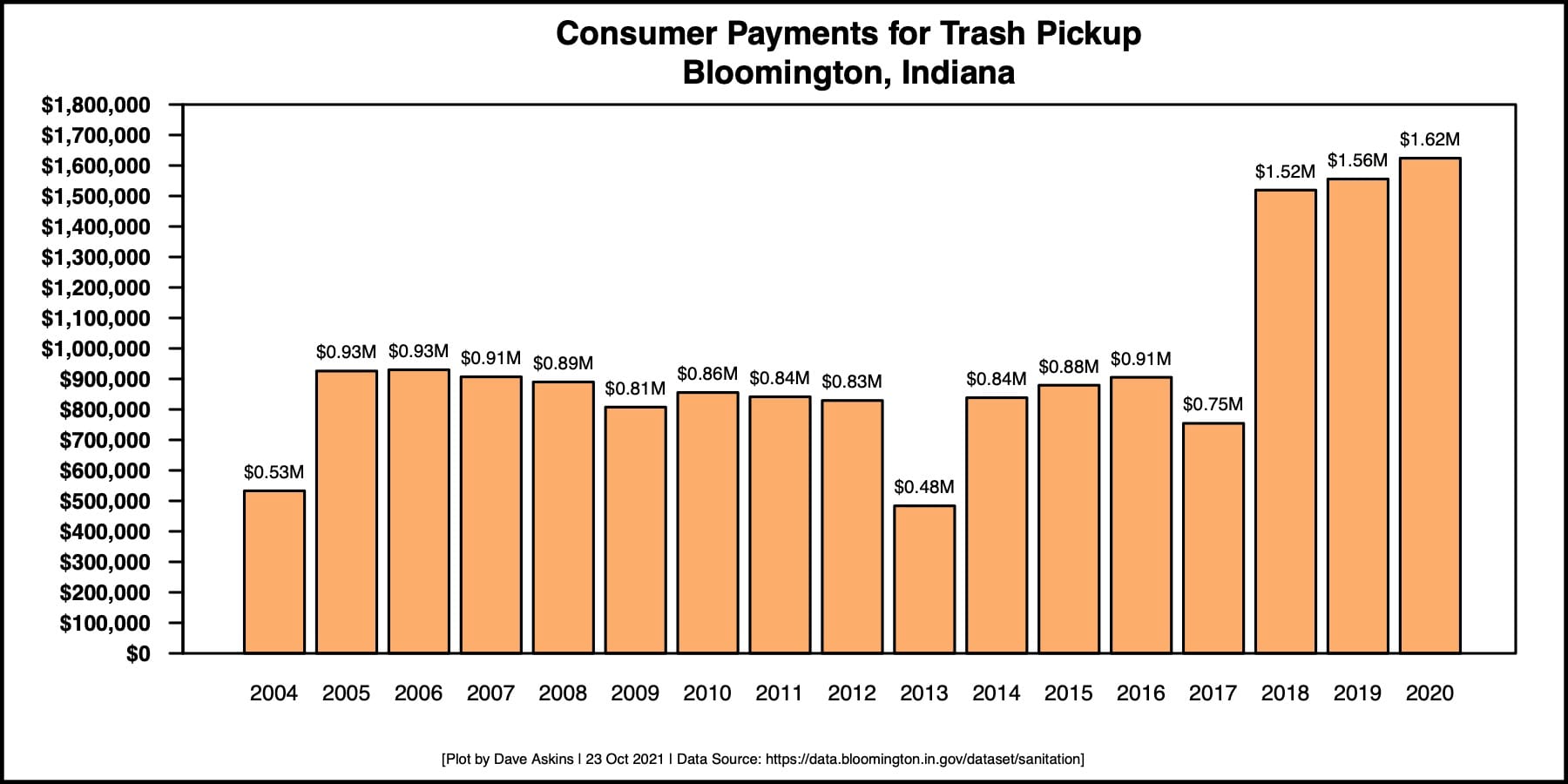
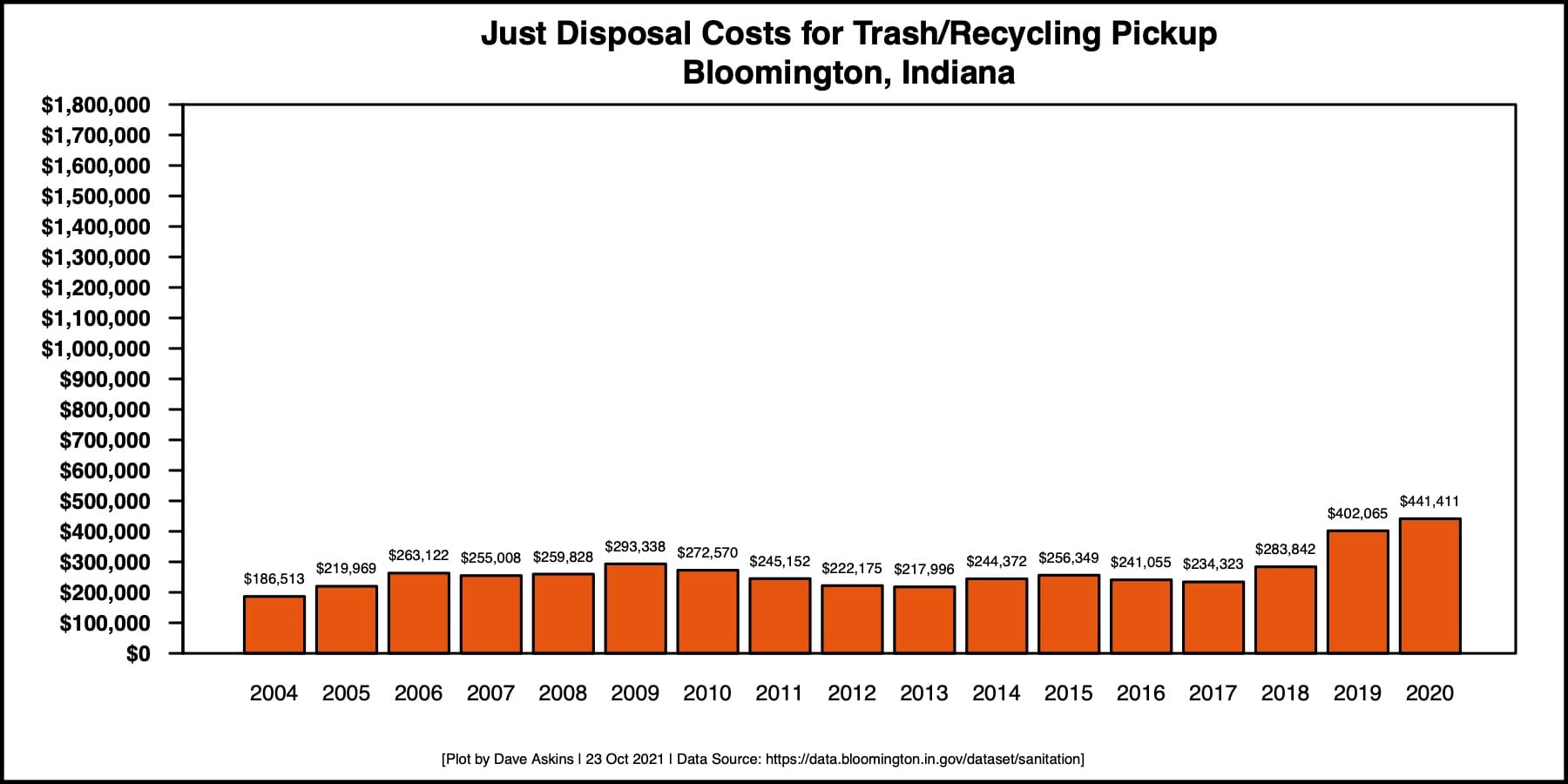
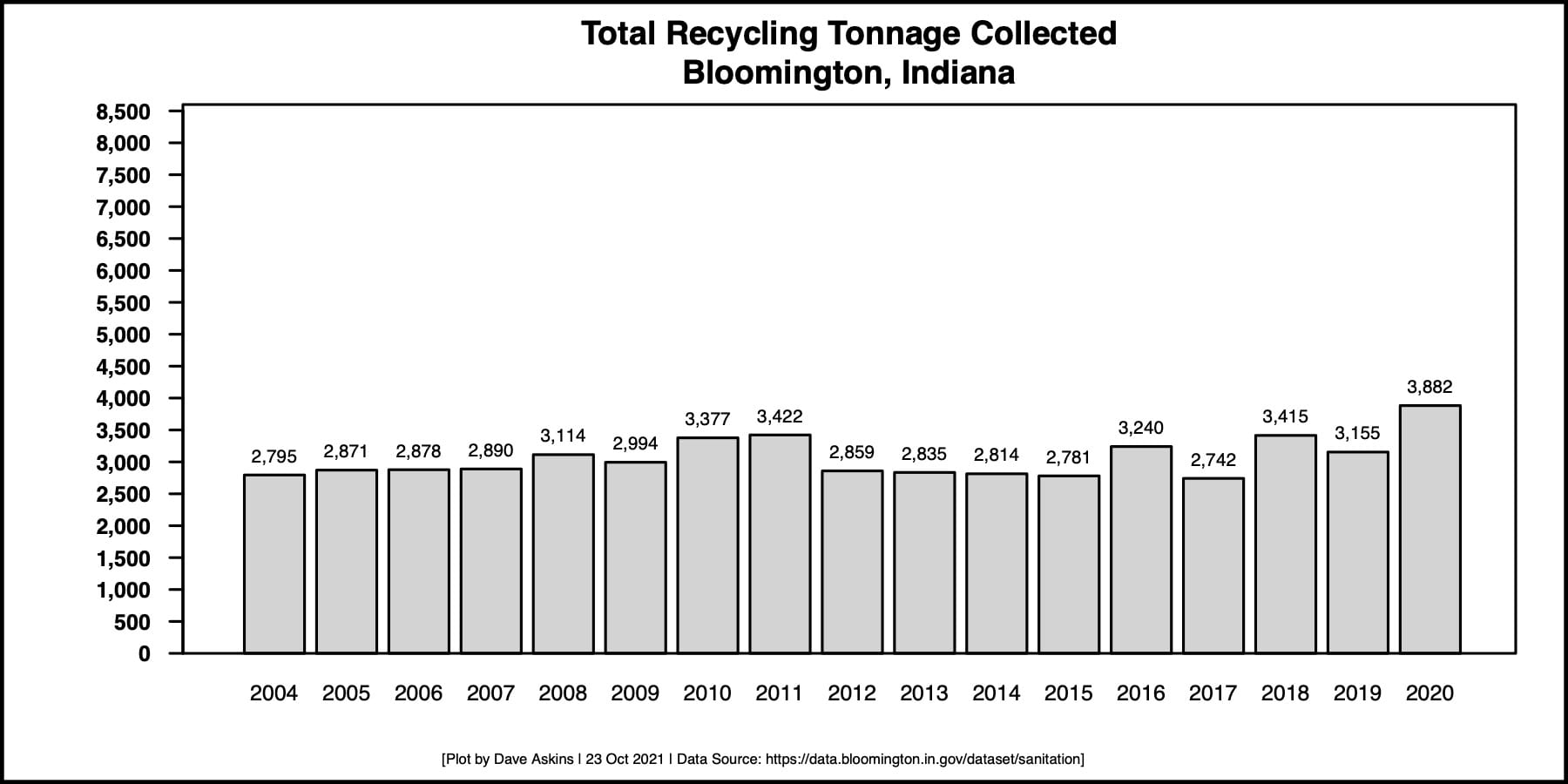
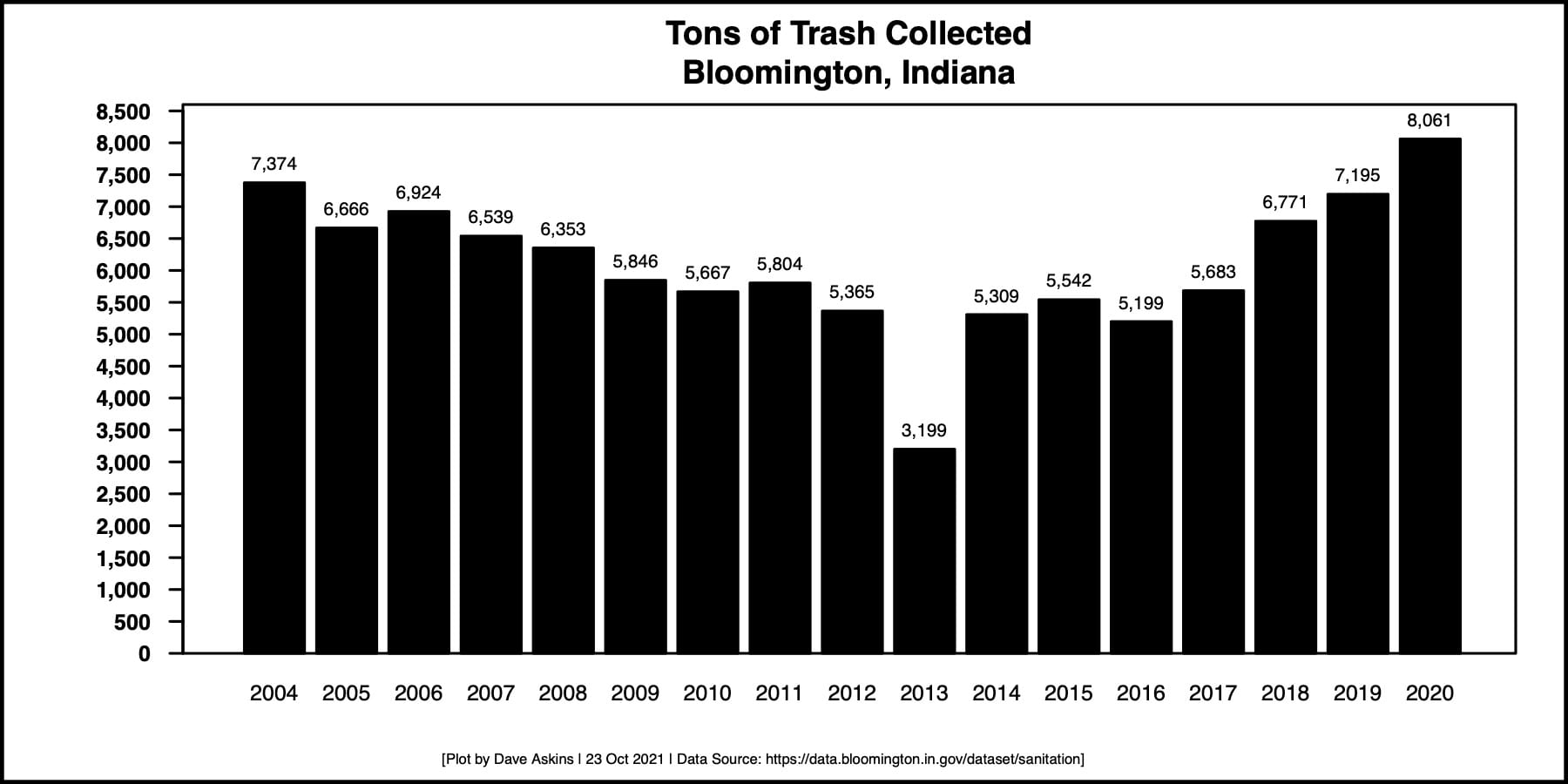
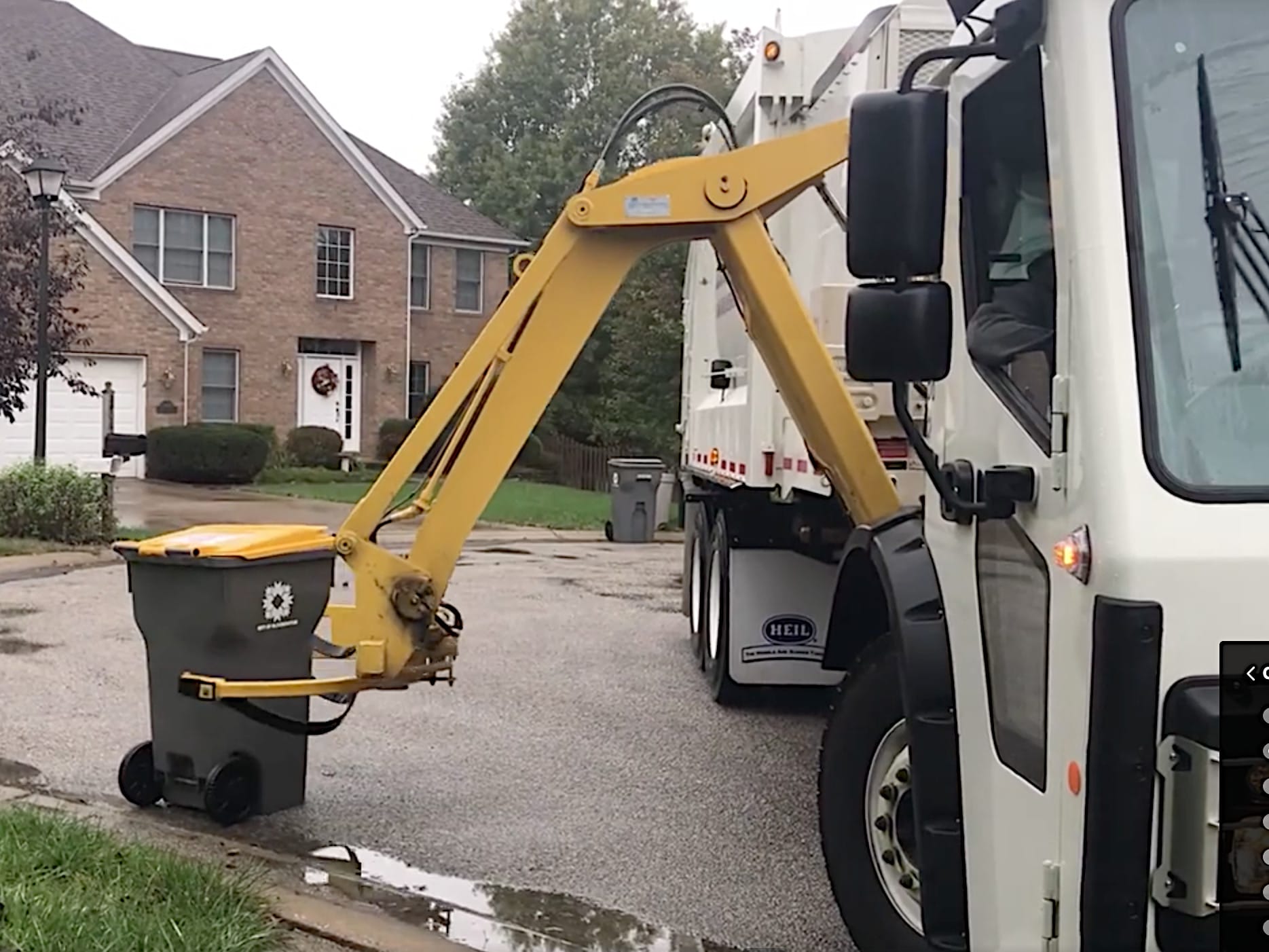
The roughly 6,000 Bloomington residents who currently pay the city $11.61 a month for weekly pickup of their 64-gallon trash cart, could see that amount more than doubled—to around $24 a month.
That kind of increase would come from applying some assumptions floated at city council sessions—like eliminating general fund support for trash pickup, and increasing rates only for medium and large carts, not for the smallest size.
While the amount and the timing of an increase is not clear, some Bloomington city councilmembers are looking at a significant increase to trash collection fees and possibly a different approach to the rate structure.
Trash cart fee increases were floated during the council’s meeting this past Wednesday, during the back-and-forth conversation after a report from public works director Adam Wason.
That kind of talk was not surprising, because councilmembers discussed trash cart fee changes during the city council’s 2022 budget hearings in late August.
The council’s action a couple of weeks ago, to retroactively approve existing rates, set the stage for Wason’s report.
The reason some councilmembers are looking to increase fees is to eliminate the use of general fund money to help cover the cost of collection and disposal. Bloomington’s trash cart program is available only to residents of buildings with four units or fewer.
Councilmember Matt Flaherty lives in a condo building with more than four units. He put it this way: “Our general fund dollars, property taxes, do not go to support our trash services. In fact, they go to support other people’s trash services, while also paying for our own trash services from a private contractor.”
Some councilmembers are also interested in adding incentives for residents to reduce their generation of waste—beyond the three choices in trash cart size, which are billed based on size. In addition to the medium 64-gallon size ($11.61 a month), the city offers a 35-gallon cart ($6.51) and a 96-gallon cart ($18.52).
The switch four years ago from the sticker system to the cart rental system is visible in charts of revenue in the dramatic increase starting in 2018. Before 2018, the average annual revenue from stickers was about $850,000. In 2018 the figure was about $1.5 million.
Bloomington does not charge any fee for its recycling cart curbside service.
In August, councilmember Steve Volan told Wason: “Mr. Wason, I would agree with you that the three sizes of bins are good. They may even be exemplary.” Volan added, “Pay-as-you-throw would be even better. It would give people even more incentive to recycle.”
By “pay-as-you-throw” Volan means a more precise measure of a customer’s waste generation than cart size, possibly based on the frequency that a cart is set out for collection.
Wason has said he’s not inclined to work on enhancing the existing pay-as-you-throw component of the city’s trash program, in part because of the already high satisfaction residents have with the city’s sanitation services, as measured by the most recent community survey.
At this past Wednesday’s meeting Volan floated the possibility of maintaining the current price of the smallest cart size.
Volan asked Wason, “When it comes time to do a rate increase, will the public works department have a problem, if council prefers not to increase the 35-gallon rate, but to increase the other two bins accordingly? Because that’s the next best thing to pay-as-you-throw.”
Wason responded by pointing to the rough distribution of cart sizes across the city: 35-gallon (6,600 users); 64-gallons (6,000) and 96-gallons (600).
Wason put it like this: “It would be a pretty hefty increase on the [two other cart sizes], based on just the allocation of cart sizes over all residents using the system.”
How big an increase would it take to generate an extra $1 million a year in revenue from just the users of the medium and large carts, leaving the smallest size carts the same? Based on The B Square’s calculations, it looks like that would require an increase to the 64-gallon cart fee from $11.61 to $23.69 a month, and an increase to the 96-gallon cart fee from $18.52 to $36.64 a month.
To generate the same $1 million, with a uniform increase across all three rate classes, would mean the following increases: 35-gallon from $6.51 to $10.85; 64-gallon from $11.61 to $19.54; and 96-gallon from $18.52 to $30.41 per month.
The $1-million figure comes from the low end of the range that’s been mentioned at council meetings for the amount of general fund money used to help pay for trash collection services.
Wason doesn’t see the elimination of general fund support for trash collection as falling within his policy making work. A decision on that would need to be made by the mayor and the city council, he indicated. As Wason put it on Wednesday, “There’s not many conversations above my pay grade. But that’s one that is, in a way, between the administration and the council.”
When he looks at the need for additional revenue, Wason looks at what’s needed to cover the costs of the operation. Wason said, “I’m not crunching numbers to determine whether or not general fund support should continue or not. I’m crunching numbers in terms of what it’s going to take to replace trucks, and cover the increased costs of recycling processing and solid waste disposal.”
The disposal cost for the city’s refuse collection—trash and recycling combined—has nearly doubled (90 percent) from 2017. In 2017 the number when it was $234,323. By 2020, it had increased to $441,411.
That increase comes in large part from the fact that in 2019 the city had to start paying Hoosier Disposal/Republic Services for the processing of recycling materials—because of the depression of the global commodities market for recycled material.
Based on the data provided by Wason to the city council on Wednesday, the city pays $45.60 a ton to landfill its trash and $26.40 a ton to have its recycling collections processed.
The most recent trash cart rate increase, approved by the board of public works in early 2020, was prompted by the need to pay Hoosier Disposal/Republic Services to take recycling material off the city’s hands, instead of getting a rebate for the goods.
The early 2020 rate increase pushed the cart fees to the maximums set by the city’s ordinance. That’s why the board of public works itself can’t again increase the cart fees even further. The city council would need to change the ordinance.
Based on remarks from councilmembers on Wednesday, conversations between the council and the administration about trash cart fees will likely continue in the near future.
A data point that could factor into those conversations are disposal costs—specifically, the average disposal cost per cart user.
Reasons that disposal costs are important include: their role in determining cost of service; their role in determining the potential monetary incentive for waste reduction.
Cost of disposal: Cost of service
Any trash cart user can be analyzed as contributing the same amount to the city’s cost of buying, maintaining, staffing, and running the trucks, which is most of the cost for waste collection. The city’s sanitation budget for 2020 was around $3 million. But the city’s cost for disposal of recycling and trash combined was $441,411.
The amount the city has to pay to dispose of the trash it collects from residents is a factor that has a direct link to differences in the city’s cost to provide service to different users of the trash collection system.
Currently, the city charges about the same amount per gallon for waste disposal (within a penny) for each of its three customer types. The per gallon rate is currently about 18 cents a gallon for all customer types.
Customers who have bigger carts are assumed to generate more trash than customers who have smaller carts. That is, customers with bigger carts are assumed to cost the city more in landfill disposal fees. The same per-gallon cart rate, when applied to a bigger cart, generates a higher fee for that cart.
If rates for the 35-gallon cart were left the same, and the rates for the other two larger cart sizes were increased enough to generate $1 million in additional revenue, that would create two rate classes—those who pay about 18 cents per gallon for their carts and those who pay about 37 cents a gallon.
It’s not clear how those two rate classes would be analyzed as consistent with a cost-of-service model of rate setting.
That’s the model that the city of Bloomington utilities (CBU) used in justifying different water rate increases for different classes of customers, when it applied this year to the Indiana Utility Regulatory Commission to raise water rates. CBU argued that the difference in cost of delivering the service to different customer classes should be the key factor that determines the rate for those customer classes.
Table: Current rates
| Cart Size | Ballpark number of Carts in Service | Ordinance: Bottom of Range | Ordinance: Top of Range (Current) | Bottom Rate per gallon | Top Rate per gallon (Current) | Annual Revenue |
| 35 Gallon | 6,600 | $4.82 | $6.51 | 0.13771 | 0.18600 | $515,592 |
| 64 Gallon | 6,000 | $8.60 | $11.61 | 0.13438 | 0.18141 | $835,920 |
| 96 Gallon | 600 | $13.72 | $18.52 | 0.14292 | 0.19292 | $133,344 |
| Total | $1,484,856 |
Table: Rates to generate +$1 million, no increase for 35-gallon cart
| Cart Size | Ballpark number of Carts in Service | Per Gallon Rate increase needed to generate $1 M extra | New rate per Gallon | New rate with zero increase for lowest tier | Annual Revenue with New Rates |
| 35 Gallon | 6,600 | 0.00000 | $0.19 | $6.51 | $515,592 |
| 64 Gallon | 6,000 | 0.18871 | $0.37 | $23.69 | $1,705,485 |
| 96 Gallon | 600 | 0.18871 | $0.38 | $36.64 | $263,778 |
| Total | $2,484,856 |
Table: Rates to generate +$1 million, uniform across cart size
| Cart Size | Ballpark number of Carts in Service | Per Gallon Rate increase needed to Generate $1M extra | New Rate per gallon | New rate with uniform increase | Annual Revenue with New Rates |
| 35 Gallon | 6,600 | 0.12390 | $0.31 | $10.85 | $859,035 |
| 64 Gallon | 6,000 | 0.12390 | $0.31 | $19.54 | $1,406,838 |
| 96 Gallon | 600 | 0.12390 | $0.32 | $30.41 | $218,981 |
| Total | $2,484,856 |
Cost of disposal: Incentives
One of the city council proposals that’s been floated as a way to incentivize residents to reduce their waste generation is to tie trash cart fees to the frequency they are set out. That’s something that can be tracked with the technology from Routeware, which is the vendor for the city’s trash collection software and hardware system.
The idea is to use pickup frequency, in addition to cart size, as a proxy for the amount of waste generated. Cart users who put out their carts less frequently would get some kind of rebate as a reward.
Councilmember Steve Volan put it this way at the August departmental budget hearing: “I, for one, don’t put out trash that often. So I want my dollar or two back a month.”
Based on data provided by Wason to the city council at Wednesday’s meeting, the average cart user in the city’s system (across all cart sizes) through the first nine months of this year has generated about 920 pounds of trash. That projects to about 1,227 pounds for the whole year.
The landfill disposal rate of $45.60 works out to 2.28 cents a pound. So the average user of a cart in Bloomington’s system is costing the city about $28 a year in landfill disposal fees.
If the city decides to apply a cost-of-service model to set trash cart fees, that means the amount the city would have available to provide as an incentive to an average cart user is around $28 per year.
In the upcoming back-and-forth between the council and the administration, some of the conversation could include the question: How many households can be motivated to reduce their waste by half, given an average incentive of $14 a year?
Table: Monthly Data on trash cart pickups through first 9 months of 2021
| TRASH Month | Monthly Accts | Total # of Pickups | Avg. # of Pickups per Acct. per Month | Avg. Pounds per Tip | Truck Loads Collected | Total Tonnage | Avg. Tons per Truck Load | Monthly Solid Waste Processing Fee |
| Jan | 13,525 | 20,914 | 1.54 | 56.23 | 64 | 588.03 | 9.19 | $26,814 |
| Feb | 13,468 | 17,109 | 1.27 | 62.47 | 72 | 534.41 | 7.42 | $24,369 |
| March | 13,557 | 29,440 | 2.17 | 50.85 | 75 | 748.50 | 9.98 | $34,131 |
| April | 13,519 | 27,147 | 2.00 | 50.52 | 68 | 685.85 | 10.09 | $31,274 |
| May | 13,566 | 23,495 | 1.73 | 59.77 | 70 | 702.15 | 10.03 | $32,017 |
| June | 13,533 | 27,280 | 2.02 | 54.19 | 72 | 739.14 | 10.27 | $33,704 |
| July | 13,511 | 29,326 | 2.17 | 49.42 | 68 | 724.68 | 10.66 | $33,045 |
| Aug | 13,115 | 31,958 | 2.44 | 48.28 | 72 | 771.43 | 10.71 | $35,177 |
| Sept | 13,533 | 28,532 | 2.11 | 50.19 | 72 | 715.98 | 9.94 | $32,648 |
Data: [Shared Google Sheet with data used for all charts and analysis]
Trash Charts









Comments ()